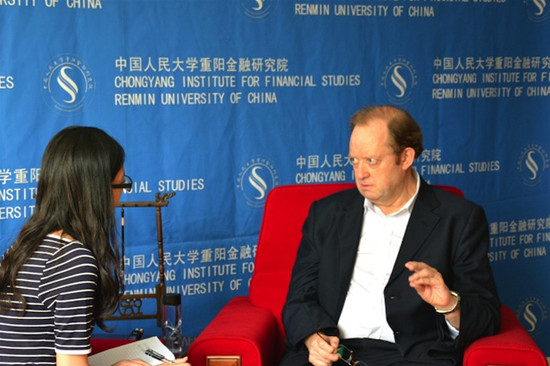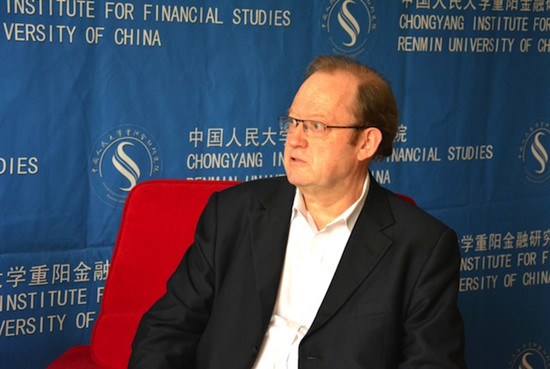伴随着过去中国经济的高速增长,中国经济也必然面临着许多“问题”。这些问题会不会演化成大规模、系统性的经济危机呢?人大重阳网就此问题继续与前伦敦经济与商业政策署署长、中国人民大学重阳金融研究院(以下称“人大重阳”)高级研究员约翰•罗思义(John Ross)进行了探讨。

前伦敦经济与商业政策署署长、中国人民大学重阳金融研究院高级研究员约翰•罗思义接受我院记者采访

罗思义认为,中国经济存在”问题“并不等同于“危机”
人大重阳网消息
伴随着过去中国经济的高速增长,中国经济也必然面临着许多“问题”。这些问题会不会演化成大规模、系统性的经济危机呢?人大重阳网就此问题继续与前伦敦经济与商业政策署署长、中国人民大学重阳金融研究院(以下称“人大重阳”)高级研究员约翰•罗思义(John Ross)进行了探讨。
“中国经济存在‘问题’不等同于‘危机’”
人大重阳网:你认为中国会发生系统性经济危机吗?
罗思义:这取决于危机的定义。我认为“危机”是经济增长的全面快速止步,而“问题”只是发生在某些特定领域之内。的确,中国面临着许多的“问题”。在过去的十年中,中国经济发展非常之快,以致产生了一些问题。比如,在过去北京没有多少人能买得起车,然而现在则因为有太多的人买得起车而导致了交通拥堵。随着人们变得富裕,交通成为了“问题”。我认为这是一个好的“问题”,我们并不能将之等同于“错误”。
当然伴随着经济的高速增长,经济政策中难免也会出现一些个别的“错误”。但是这些错误并不会导致经济增长的止步,也不会演化成大规模的、系统性的危机。预测危机是很难的,但是预测“问题”却是相对容易的。目前中国面临的问题之一是对欧美国家经济复苏速度估计过高。事实上,美国经济的复苏并不强劲,从历史标准来看反而是相对较低的。对出口的高估造成中国去年出口并没有达到增长10%的既定目标。另一方面,这还导致中国忽略小规模经济刺激政策。幸运的是,7月24日政府及时出台了一些新的举措。首先是政府暂免征收部分小微企业增值税。由于经济增速的放缓,加上流动性风险,银行贷款会优先考虑大企业,这使小微企业融资难,发展步履维艰。第二项举措面向出口商。世界经济疲软,而中国是世界经济链的一环,中国的出口商必然面临不少问题。第三项举措则是加快铁路建设。我认为当下恰好需要这些刺激政策。
“中国消费拉动增长的模式需改变”
人大重阳网:你认为中国经济的发展还面临着那些主要的问题?
罗思义:我认为最重要的问题并不是观念的问题,而是客观的问题。与美国相比,中国的投资积累水平还处在一个比较低端的位置。美国有着两百多年的投资积累,而中国只有大约三十年左右的时间。此外,中国的人均投资仅仅是美国的四分之一。以中国铁路为例,中国的人均铁路投资仅仅是美国的十分之一。就铁路运输的效率而言,中国的运输系统比美国要落后许多。这意味着中国在长期内还需保持高水平的投资。
短期来看,我认为中国也存在着一些错误的经济理论。其中之一是“消费拉动增长”模式。我认为这一理论完全没有理解“市场经济”的含义。事实上,市场经济只能是“利润拉动增长”,而不会是“消费拉动增长”。这一理论认为快于GDP增长速度的工资增长会拉动消费,更高的消费水平则会最终拉动GDP的增长。这种逻辑是完全不合理的,因为提高工资必然意味着利润的降低。长期以来,中国许多省份的最低工资增加了20%到22%,而GDP却只增长了10%,这预示着“利润危机”的出现。由于利润被快速增长的工资抵消,投资与生产也就相应减少,反过来又会导致消费增速放缓。如果工资增长的速度超过了GDP增长的速度,人口的收入增长率不仅不会增加,反而会因为利润的降低而导致经济增长的缓慢。因而,“消费拉动增长”理论在当下根本站不住脚。发展市场经济只有依靠“利润拉动增长”理论。
另外,六月发生了“信用危机”。从最近的企业贷款利率中我们可以发现,许多企业对现金有着非常迫切的需求。企业需要这些现金做什么?它们并不是用来投资,而是用来支付日常运营开销,例如支付工资、购买原材料以及支付供应商。企业新的投资减少了,而大量现金用于日常开销,我们由此可以看出,信用扩张对经济增长的刺激作用正在变得越来越小。
摒弃“工资增速应快于GDP增速”观点的唯一途径在于向无逻辑的“消费拉动增长”理论说“不”。一般说来,工资增速应与GDP增速保持一致,而不是快于GDP增速。简单说来,应停止采取挤压利润份额的政策,因为GDP中工资比例的增加必然意味着利润占比的下降。
另外一个问题是中国城镇化政策推行中的矛盾。毫无疑问,城镇化道路是正确的,首先,相对发达的国家几乎都完成了城镇化。此外,城镇居民的人均GDP是农村的大约三倍,人口从乡村到城市的流动无疑将会提高生产率。然而,有些人可能会幻想政府支出占GDP的比重会在城镇化的进程中减少,这显然是不符合实际的。如果参考别国的经验,例如美国自第二次世界大战以来,其政府支出占GDP的比重已经由7%上升到27%。虽然美国一直宣称自己是一个拥有“小政府、大市场”的国家,但人们会在美国城镇化进程中发现其政府支出规模是在增大的。城镇化建设不仅需要巨大的基础设施投入,而且城市居民也比农村居民有着更为强烈的社会保障需求,这些都意味着政府支出只能越来越大。“小政府、大市场”只是一种幻象。
用金融统计数据表现中国城镇化进程将清晰表明,GDP中政府支出下降是完完全全错误的。因而,采取减少GDP中政府支出来发展城镇化是不可取的。但由于所有发展城镇化的国家都是采取增加GDP中政府支出的方式,目前还不存在可以替代这一举措的政策。
新的问题却随之出现。随着政府投入的增加,GDP中税收的比例也会相应增加,原因在于应对政府支出增加的最有效途径之一则是征税。然而长期看来,这显然是不可持续的,中国下一步政策的着眼点应放在建立更有效率的税收体系上。(人大重阳风迅、元帅青 记录整理)
以下是英文采访原文:
Q: Do you think that China will get into the trouble of systemic crisis?
A: It depends on what you would call a crisis. Let me call a ‘crisis’ something that causes rapid growth in the economy to come to a stop. A ‘problem’ would be something which has significant negative effects in a particular economic area but doesn’t cause overall rapid growth to halt.
Yes, I think there are bound to be ‘problems’. The economy has doubled in size every ten years. To take a very simple example, ten years ago a ‘problem’ in Beijing was that not enough people in had cars, as their incomes were not high enough to afford them! Now the problem in Beijing is so many people have cars, the traffic has difficulty in moving. Therefore the traffic has become quite a significant economic problem because people got richer. So it’s a good problem to have and I don’t think of it as mistake. There will of course be more serious problems but they will not stop rapid growth in China’s economy.
Yes, naturally there have been individual mistakes in policy in the past years –individual mistakes are inevitable but these do not amount to a ‘crisis’ in the sense of something that will produce systemic collapse or the end of fast growth. They are just inevitable problems in a rapidly growing economy.
One issue is China’s overestimated speed of recovery of the Western economies from the international financial crisis. You mentioned that it is written in parts of China’s media that there had been a significant recovery of the US’s economy, but it not true by historical standards. Growth in the US’s economy is very low by these measures and it’s going to stay very low.
Because of this overestimation of speed of recovery in the advanced economies there was overestimation of China’s export potential. That’s why the 10% target for trade last year was not achieved - because the condition in the advanced economies was less favorable than foreseen. That in turn meant there was an underestimation of the need for a small domestic stimulus in China.
Fortunately, yesterday the government announced some new measures. First, the government will temporarily suspend VAT on small companies. Small companies have going through a hard time because, with slowdown in growth, and the liquidity crisis, the banks would give preference to loans to big customers – which did not help small companies. Secondly, help is being given to exporters - exporters have had problems because the world economy is weak and China is integrated in the world economy. The third measure is to speed railway construction. I think this is the correct time for these measures.
Q: what are the main problems and obstacles when China is on her way to be stronger? How can we solve them? Do you have any suggestions?
A: Well the biggest problems are objective problems. The level of accumulation of investment in China is still very low compared to the US. First, the annual investment per person in China is still only one quarter as much as in the US. Second, the US has rapidly been accumulating investment in its present form for 200 years while China has been doing it during its reform period for only slightly over 30 years. If you take the amount of the railways in China for example, it is in only one tenth of the amount of the railway per person in the US. That means the transportation system in China is much weaker than the system of the US. These facts mean China has to carry on very high level of investment for a very long period of time in order to be able to catch up with the US.
So the biggest problems are not the problems of ideas at all. I wish I could tell you if you get the right idea and you walk out this room China would almost immediately become a rich country. But it is not possible. All these real accumulations take time. So the biggest problem is the objective problem.
Nevertheless in the short term I think there are confused economic theories in China, which do damage. One of them is the entirely confused idea of “Consumer Led Growth”. This literally does not understand what a market economy is. A market economy can only be ‘profit led growth’ The confused idea in ‘consumer led growth’ is that raising wages faster than GDP will create more consumption and GDP will therefore grow due to this – consumption will ‘drive’ the economy.
But this is entirely incoherent. Raising the percentage of wages in GDP necessarily means reducing the percentage of profits in GDP. For example increases in the minimum wage of 20% to 22% have been carried out in some provinces while GDP is growing at 10%. This reduction of the share of profits in GDP will necessarily cause a profits crisis in companies. This in turn will cause investment to fall, the rate of growth of the economy to slow, and therefore consumption to rise more slowly. So profit is going down due to too rapid wage increases compared to GDP increases. But this is not increasing the rate of income growth of the population but on the contrary this is slowing as the economy grows more slowly due to lower profitability.
So the whole theory of ‘consumption led growth’ is entirely false and has to be replaced by an understanding a market economy can only work by ‘profit led growth.’
Secondly, there was the credit crisis in June. From the increase in the loan rate in June we know that companies were desperate to have cash. Why did they need cash? They didn’t need it to make investments – the rate of increase of investment was falling. They needed cash for day-to-day operations to pay wages, suppliers and to purchase raw materials etc – and therefore they needed money from banks to meet these costs.
In addition to the immediate liquidity problems the lower growth rate of profitability of companies also meant credit expansion was less effective in generating growth because this credit did not go into investments, which will only be made if they are profitable and which if made will generate growth, but to meet day to day expenses. Therefore the credit expansion became less and less effective in stimulating the economy.
The only way out of this is to stop the policy that wages should grow more rapidly than GDP – that is the incoherent idea of ‘consumption led growth’. In the immediate situation wages should grow in line with GDP not more rapidly. Put in simple terms the policy of reducing the profits share in the economy should be stopped – as raising the percentage of wages in GDP necessarily means lowering the percentage of profits in GDP.
Another problem is contradictions in urbanization strategy. The urbanization strategy is absolutely right. First, every country which is rich is urbanized. Secondly, today the GDP per capita in urban China is three times the GDP per capita in rural areas. Therefore moving the population from the countryside over a period of time will produce very big increase in productivity.
But in China there is an illusion in some places that the percentage of government expenditure GDP is going to down. This won’t happen. On the contrary with urbanization and development the percentage of government expenditure in GDP will rise – this is shown by the experience of all countries.
To show this take the example of the US. The US is officially a ‘small government’ country, but actually the share of government expenditure in GDP has persistently risen. Indeed US civilian government expenditure has risen from 7% of GDP to 27% of GDP since the end of World War II.
Government expenditure will rise as a percentage of GDP in China with urbanization as urbanization is incredibly expensive. First, the huge infrastructure construction will cause more government expenditure. Secondly, the urban population does not have some forms of social protection that the rural population have, therefore when a society is becoming urbanized, the need for social protection increases – expenditure on education, health, social security all rise more rapidly than GDP as the US shows. This means that the government expenditure is bigger and bigger. ‘Small government and big market’ is not going to happen, the share of government expenditure in the economy is only going to get bigger.
The moment the financial calculations were done in China on urbanization they would tell you immediately that theory the percentage of government expenditure in GDP was going to fall is wrong. Therefore a plan which reflected this financial reality which was drawn up was not accepted. But nobody came up with an alternative plan because no country which has undergoing urbanization has seen anything except the percentage of government expenditure in GDP rise. This is simply contradictory.
Then another key question follows. As China will have bigger government expenditure, the percentage of taxation in GDP will have to rise because in the long run taxation is the only way to finance the government expenditure. Therefore it has become an urgent matter for China in the next ten years to create a more efficient taxation system.